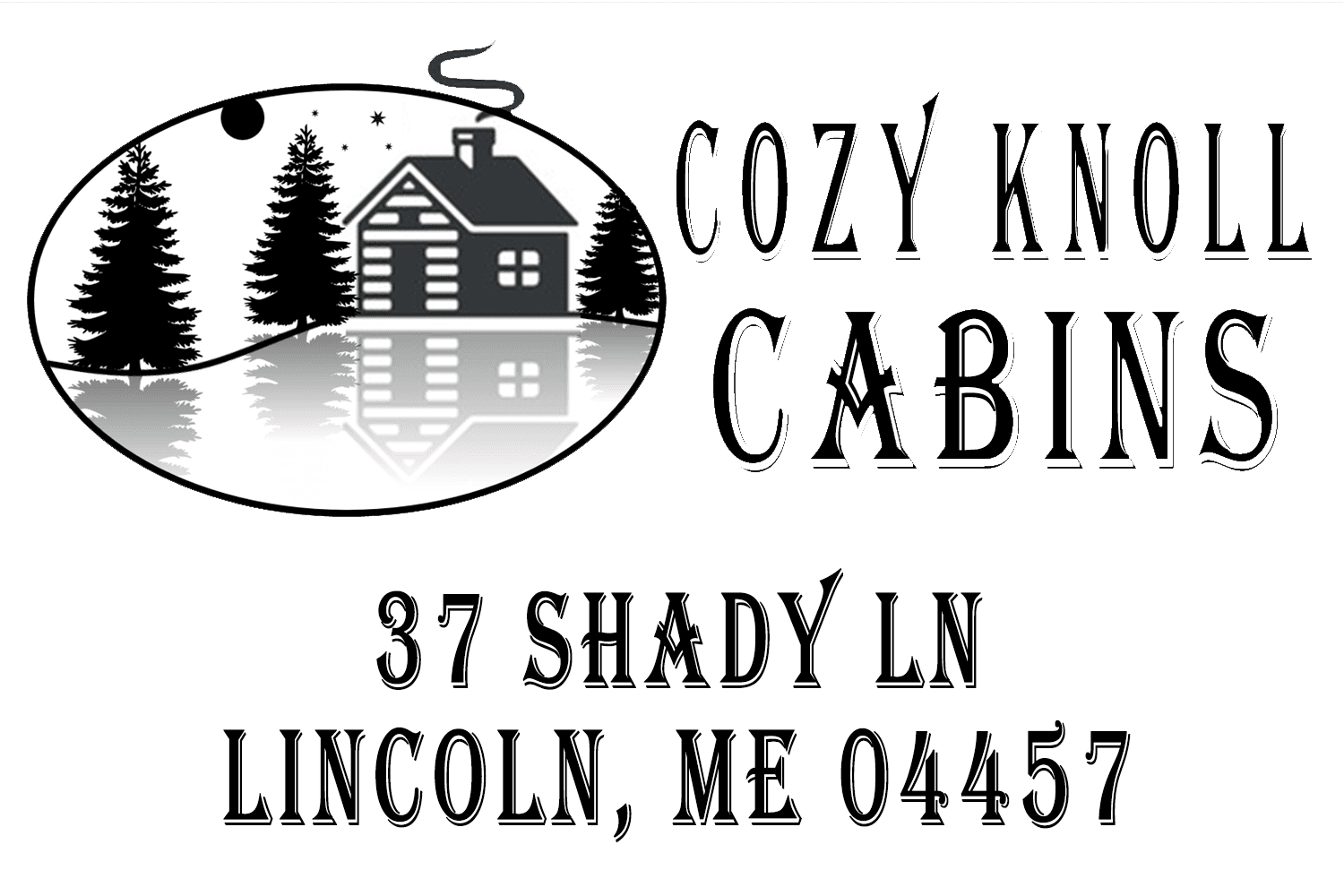Things to do Near Lincoln, Maine
We can keep you busy for many vacations
Lincoln, Maine is a premiere spot for any recreational activity involving water. Having more than 70 miles of water frontage on 13 lakes – all Cozy Knoll Cabins are located directly on the shore of Center Pond, there’s no shortage of places to get your water fix, or just have a cook-out next to the water. See our ‘Lakes’ page for boat landing info.
For motorized outdoor activities, regardless of season, Lincoln, Maine is an excellent destination, and Cozy Knoll Cabins is your gateway. Snowmobile and ATV riders have hundreds of miles worth of trails awaiting them, literally feet away from the cabin sites. You can’t find a better place anywhere for an adventurous exploration of Maine’s woods – while still keeping close to civilization for supplies.
Water isn’t Lincoln’s only attraction. If you’re looking for out of the ordinary things to do, take a selfie with our loon, paint a rock, go for a short or a long hike, visit one of our historical sites; this list could go on for a while.
Lincoln has a rich history that can easily be discovered, and some of it revisited. Not far from Lincoln are historical sites like the Elephant Mountain B-52 crash site, or the locomotives in the forest – both are surreal and amazing at the same time.
From Acadia National Park to Katahdin Iron Works State Park; hundreds of miles of hiking trails, beautiful waterfalls and swimming holes, and unmatched scenery are at your fingertip for adventure.

LOON SELFIE
While Lincoln may be known for it’s lakes and fishing, the area also has a lot of wildlife. That wildlife includes the loon – lots of them. In fact, the loon is the town’s mascot.
You can take a selfie with Lincoln’s own 13 foot loon – quite a popular attraction for visitors when they arrive. The Lincoln Loon selfie is quite a common occurance, happening several times a day during the summer and winter months alike. It’s truly unique.
Located right on Main St, next to the gazebo, Lincoln’s trademarked loon is really hard to miss. Doing a web search for the Lincoln, Maine loon will pull up MANY images from news articles and social media.
Next time you’re in the Lincoln area, snap a selfie, and add your own image online.
Loon Selfie

Lincoln certainly has it’s share of water. Our 13 lakes make for some awesome fishing and boating. However, we also have some great swimming in the local and surrounding area.
Prince Thomas Park in downtown Lincoln is a wonderful place to swim, or ice skate depending on the season.
Morgan Beach, which is a short drive to Enfield, is a great family fun spot in the summer time. Located on Cold Stream pond, the beach is a cozy place to enjoy a hot summer day.
About an hour away from Lincoln, located in the Katahdin Iron Works State Park, is Gulf Hagas – aka The Grand Canyon of Maine. Small and large waterfalls, and clear mountain pools to swim in.
On the west side of Baxter State Park in Medway, Ledge Falls is a great place for some watery fun. The naturally formed rock slides are a blast for the kids and adventurous adults alike.
swimming
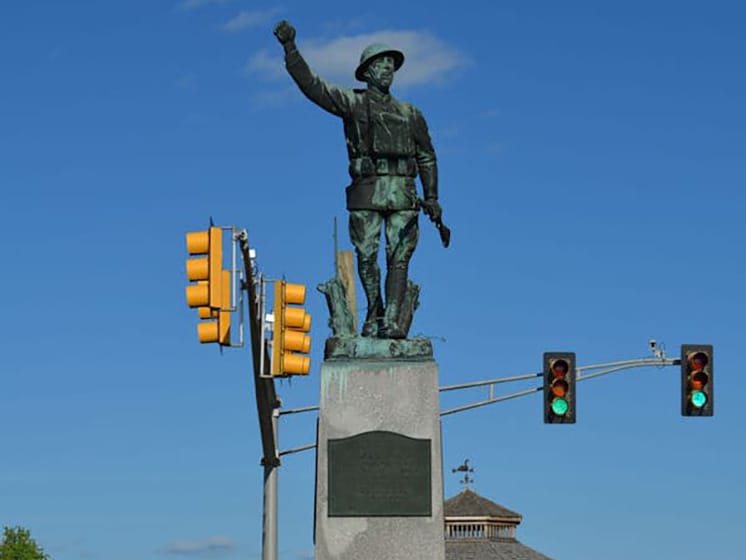
LOON SELFIE
The town of Lincoln has a rich history of men and women who have served their country with distinction in the armed services. The town folks have honored their sacrifices, and erected several memorials around town over the years so they would not be forgotten.
One of the most notable was master sergeant Gary Gordon, a member of the Army’s Delta Force who valiantly gave his life in the battle of Mogadishu in 1993, and received the Medal of Honor for his actions. His story and selfless actions are recounted in the book and movie Black Hawk Down, and there is a statue and memorial to him in town.
There are other notable monuments around town, including the WWI Doughboy statue pictured above, and a Civil War monument that has stood in town since 1887.
With so many things in town we are free to enjoy, it is fitting to take a moment of our time to remember the men and women who fought to give us those freedoms.
monuments

LOON SELFIE
Spring, summer, and Fall are great times to play golf, and Lincoln has you covered if you are longing for the links.
Jato Highlands is an 18-hole par 72 course located in Lincoln that will prove both challenging and enjoyable for any golfer. They offer everything you’d expect from a quality course, including a pro shop, carts, lessons, and more.
Just next door to Lincoln in West Enfield is Barnes Brook Golf Course, a 9-hole course that is enjoyable to play. Mike and the staff are super friendly, and their kitchen makes an excellent pizza if you are hungry after a round.
Both, JATO Highlands and Barnes Brook, golf courses are a short drive from Lincoln, meaning they’re a short drive from Cozy Knoll Cabins. So if you’re a golf fan who is planning a spring or summer trip to Maine, you can sleep at Cozy Knoll Cabins, and have your choice of two golf courses!
golf
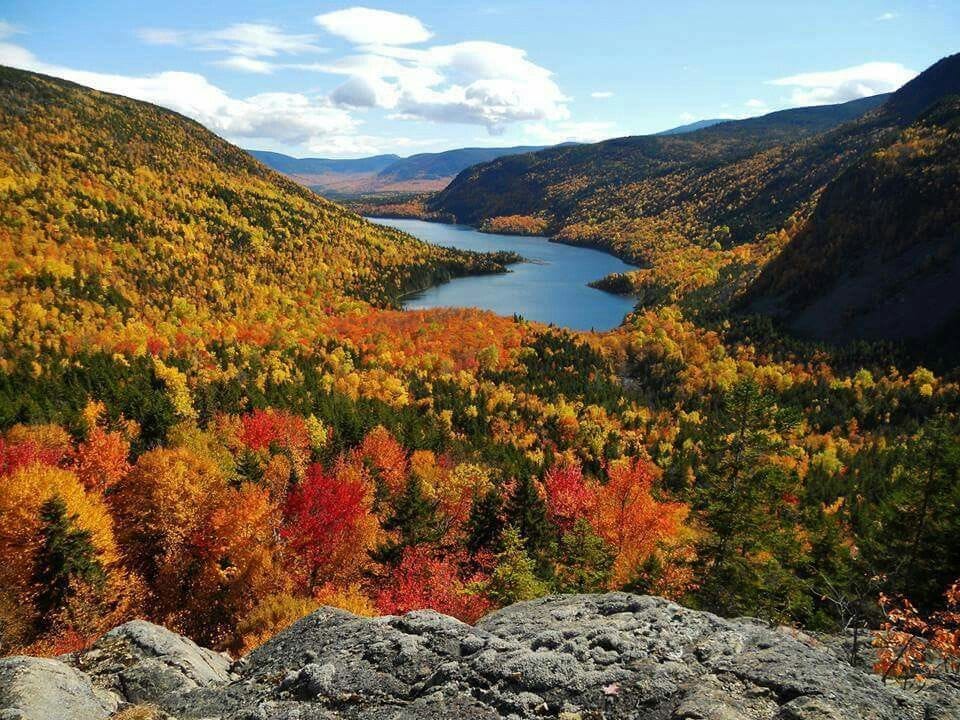
LOON SELFIE
For an almost other-worldly experience, a short drive from Cozy Knoll Cabins is Baxter State Park, featuring Mt. Katahdin.
Baxter State Park is the result of a dream of former Governor Percival P. Baxter who donated the first parcel of land in 1931 and over the years added various parcels until his final acquisition in 1962 brought the Parks area to 201,018 acres. Since then, the Authority has purchased and been gifted additional acreage to bring the Park to its current size of 209,644 acres. In addition to the various gifts of land, Governor Baxter also left two sizeable trust funds to carry out the operation and maintenance of the Park without the need for state funding.
While Baxter State Park bears the name State like many parks it is separately administered, free from any connection with the larger State Park system Bureau of Parks and Lands/Dept. of Conservation. The Baxter State Park Authority, a three-person authority consisting of the Attorney General, the Director of the Maine Forest Service and the Commissioner of Inland Fisheries and Wildlife, has full power in the control and management of the Park and in the exercise of all Trust obligations.
Percival P. Baxter was governor of Maine during the years of 1921-1924. He enjoyed fishing and vacationing in the Maine woods throughout childhood and his affection for the land and Maines wildlife were instrumental in his creation of a park for people of the State of Maine. He began to fulfill his dream of a park in the year 1930, with the purchase of almost 6,000 acres of land, including Katahdin, Maines highest peak. In 1931, Baxter formally donated the parcel to the State of Maine with the condition that it be kept forever wild. Over the years, Governor Baxter purchased additional lands and pieced his park together, transaction by transaction. He made his final purchase in 1962 download map. Since then,additional purchases and land gifts have increased the Parks total size to 209,644 acres. About 75 of the Park 156,874 acres is managed as a wildlife sanctuary. In the northwest corner of the Park 29,537 acres about 14 of the Park was designated by Governor Baxter to be managed as the Scientific Forest Management Area. In addition, about 25 of the Park 52,628 acres is open to hunting and trapping with the exception that Moose hunting is prohibited in the Park.
Baxter’s dirt roads are narrow. Park facilities are described by the Friends of Baxter State Park as “rustic and without electricity.” Want a hot shower? Take it at home; there are no showers, only outhouses. If you come, bring your own water or plan to treat the water available. In fact, plan to bring everything—food, clothing, sleeping and cooking gear, etc. And when it’s time to head for home, pick up all your garbage and take it with you.
Perhaps the greatest challenge, one that draws many each year, comes from 5,267 ft. Katahdin, named by the Penobscot people and dubbed a National Natural Landmark by the federal government. Ascending this granite giant means an elevation gain of around 4,000 feet. This strenuous, and sometimes technical, climb takes an average of eight to 12 hours. The park offers specific guidelines, trail maps, and advice on what to expect when hiking in the park and on the peak.
Yet despite its many challenges, Baxter has legions of fans. The park is like no other on the East Coast. Visitors enjoy unparalleled solitude. They can sleep with only the sounds of the wind, the birds and the rustle of trees. And they stand a good chance of seeing many of the animals of Maine, including moose, black bear, white-tailed deer and lynx.
baxter state park
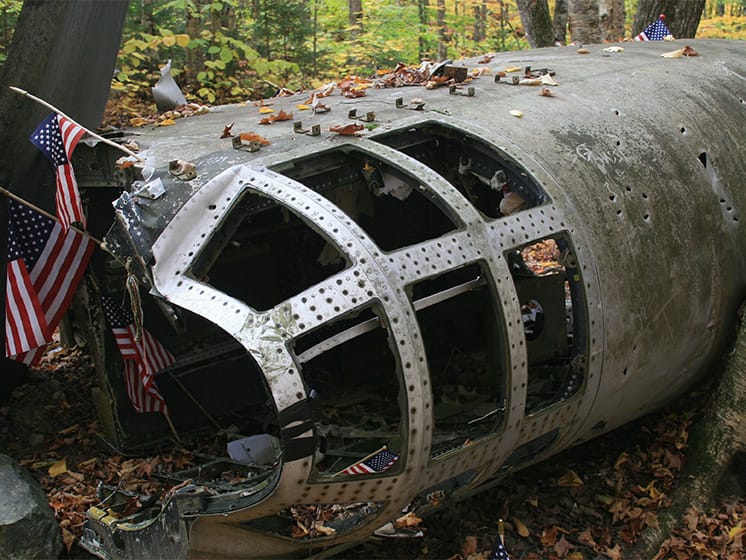
Visitors to Moosehead Lake may not realize that eight miles into the woods on the southern slope of Elephant Mountain is a crash site of a giant United States Air Force Boeing B-52C Stratofortress. The pieces of wreckage and aircraft debris cover several acres of forest. You are free to wander through this living memorial of a Cold War tragedy.
On a brutally cold January afternoon in 1963, nine crew members took off from Westover AFB in Massachusetts in the subsonic, jet-powered strategic bomber on what should have been a routine training mission. The aircraft, however, ran into turbulence from gusts buffeting off the mountains of western Maine. Those strong winds triggered a structural failure; part of the bomber’s tail was torn off. Unable to level the B-52C, the pilot ordered the crew to abandon it.
Only three crew members – all on the top flight deck – had the time and means to eject. The co-pilot, Maj. Robert J. Morrison parachuted from the bomber but was killed when he hit a tree. Navigator Capt. Gerald J. Adler is the only person ever to survive an ejection from an aircraft without the parachute opening. He landed upright in the snow in his ejection seat, fracturing three ribs and his skull. The third survivor was the pilot, Lt. Col. Dante E. Bulli, who spent the night dangling from a tree 30 feet above the ground in minus 29-degree temperatures.
The remnants of this crash lie at the end of a tree-lined road only fifteen minutes from the town of Greenville. Lily Bay Road on the southern shore of Moosehead Lake intersects with an easy-to-miss turnoff marked with a small sign that reads: Prong Pong Road. This unpaved path is rutted and rugged, but the breathtaking landscape is worth the bumpy, jarring eight-mile trek up Elephant Mountain. Along the way, you will be entertained by an alternating dance of pine, spruce and oak trees, and every color and variety of Maine wildflower. The road is popular with ATV and snowmobile enthusiasts and there are numerous side paths that offer views of the mountains of Piscataquis County as you approach the trailhead.
The crash site is easy to find thanks to small placards at every fork and junction. A sign at the entrance to the trail placed by the owner, Weyerhaeuser, asks visitors to treat the area respectfully and leave it intact. Drooping tree tendrils beckon you into the woods and the first fragments of debris lay only 20 steps deep. It is a heady, emotional place, not the least for being in the midst of a dense old pine forest.
B52 Crash
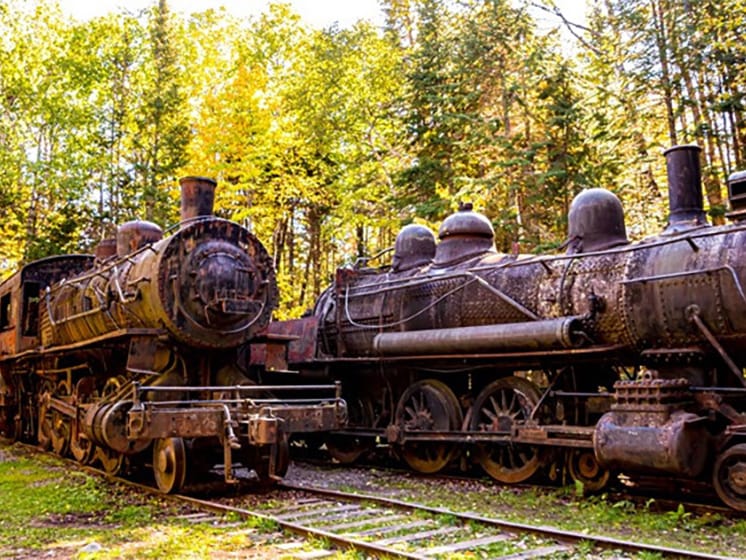
LOON SELFIE
Hidden in the 17.5 million acres of forest spread across the state are a number of abandoned sites. These include vacant paper mills, deserted homes, old forts, and underground bunkers. But one of the most interesting things you’ll find in the woods of northern Maine are a pair of long-forgotten locomotive engines, rusting away in the middle of nowhere.
Maine’s “ghost trains”, as they have come to be called, are not easy to find. Buried deep within the North Maine Woods, the trains, which sit near Eagle Lake, can only be accessed by following a confusing network of dirt roads, which seemingly lead you further and further away from civilization.
They’re not completely off the grid, however. If you follow the directions provided by blogger Derrick Grant on Maine Passport, which get you to the ghost trains in 32 easy steps (lol), you’ll find you can nearly drive right to the clearing they occupy.
Grant, who visited the site in August 2022, tells you step by step how to make your way to a parking area that sits less than a mile from the locomotives. A walking trail that runs parallel to nearby Eagle Lake will take you the rest of the way, straight to the eeriest “train station” you may ever encounter.
The clearing with the two locomotives at its center is like a snapshot out of Alan Wake — which is to say, if you stayed past dark, you might get the sense you were walking around on the set of a real-life horror movie. Aside from the main attraction, old, rusted railroad equipment can be found littered all around the area, making it a sort of living museum. You can look and touch, but it’s probably a good idea to bring gloves, lest you slice your finger open on some sharp, rusty metal.
Now that we’ve handled the “what” and the “where”, let’s spend a little time on the “how” and the “why”, as in: how did all of this stuff end up here, and why was it left behind? For those answers, we have to travel all the way back to 1926. That’s the year a Canadian lumber baron by the name of Edouard “King” Lacroix began hauling materials to build a railroad deep in the woods of northern Maine for the purpose of transporting logs from the areas surrounding Churchill and Eagle lakes down to the Penobscot River.
Before the railroad went into operation, however, the Great Northern Paper Company bought Lacroix out. Shortly after, Great Northern oversaw the first successful trip of what they deemed the Eagle Lake & West Branch Railroad on June 1, 1927.
Over the next six years, the railroad transported nearly a million cords of pulpwood, but as paper demand dropped amid the Great Recession, the railroad ultimately shuttered in 1933. According to Maine’s Department of Agriculture, Conservation & Forestry, the pair of 100-ton locomotives that drove the whole operation were left behind because they were “relatively obsolete” and “not worth the cost of transporting” out of the remote wilderness. The trains were left inside the engine house, which subsequently burned down in 1969, leaving them exposed to the elements.
Over the years, visitors to the site, which became a popular attraction for snowmobilers, pilfered all kinds of souvenirs from the locomotives, such as gauges, bells, and number plates. By the ‘90s, only the shells of the once-great behemoths remained, a rusting reminder of an industrial age long gone by, but one that you can visit still today — as long as you’re willing to take a hike.
ghost trains
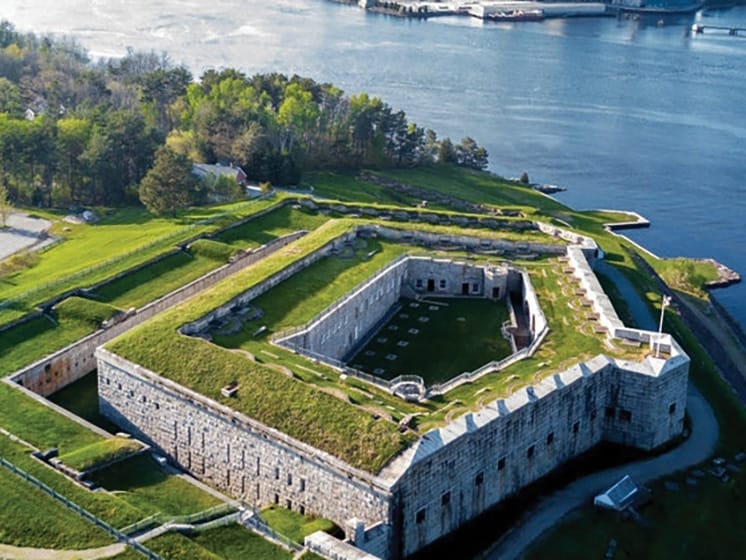
LOON SELFIE
Located on the west bank of the Penobscot River in Prospect, Maine, in an area known as the Penobscot Narrows, Fort Knox is one of the best-preserved military fortifications on the New England seacoast. The fort has many unique architectural features, as well as a rich history behind its walls.
During the country’s infancy, Maine was repeatedly involved in northeast border disputes with British Canada. In fact, the area between Castine and the rich lumber city of Bangor was invaded and occupied by the British during the American Revolution and the War of 1812. Fort Knox was established in 1844 to protect the Penobscot River Valley against a possible future British naval incursion.
Chief Engineer Joseph TottenThe fort was designed by Chief Engineer Joseph Totten with a number of other engineers serving as superintendents of construction from 1844 – 1869, among them Isaac Ingalls Stevens and Thomas L. Casey. The fort was named for Major General Henry Knox, America’s first Secretary of War, who was born in Boston but retired to Thomaston, Maine in 1796. The fort garrisoned its first troops from 1863 to 1866. These troops were mostly volunteers undergoing training before being sent to their active posts, and included members of the celebrated 20th Maine. Troops were also briefly stationed at the fort during the Spanish-American war in 1898, but never saw military action.
Come explore the fort and discover this treasure of Maine and United States history. Fort Knox is open May 1 – October 31, from 9:00 – sunset. The grounds are open year round for your visiting pleasure.
fort knox

LOON SELFIE
Taller Than the Statue of Liberty!
The Penobscot Narrows Bridge and Observatory is the crown jewel of coastal Maine, offering spectacular 360-degree views of the Penobscot River and Bay, the Maine countryside and the distant western mountains. Tourists and travel writers alike have been attracted to the unique character of this structure, its historical significance and the stunning vistas. Engineering and transportation geeks are fascinated by the award-winning and innovative design. Visitors of all ages and interests will enjoy this unique campus that includes:
- The tallest public bridge observatory in the world;
- Historic Fort Knox;
- Picnic tables and grills;
- A diversity of interpretive panels explaining the history of the region, natural wildlife of the area and more;
- A covered pavilion for hosting family reunions, small weddings and other special events; as well as
- Perfect backdrops for your vacation or family photos
penobscot observatory

Acadia National Park is an American national park located along the mid-section of the Maine coast, southwest of Bar Harbor. The park preserves about half of Mount Desert Island, part of the Isle au Haut, the tip of the Schoodic Peninsula, and portions of 16 smaller outlying islands. It protects the natural beauty of the rocky headlands, including the highest mountains along the Atlantic coast. Acadia boasts a glaciated coastal and island landscape, an abundance of habitats, a high level of biodiversity, clean air and water, and a rich cultural heritage.
Acadia has a rich human history, dating back more than 10,000 years ago with the Wabanaki people. The 17th century brought fur traders and other European explorers, while the 19th century saw an influx of summer visitors, then wealthy families. Many conservation-minded citizens, among them George B. Dorr (the “Father of Acadia National Park”), worked to establish this first U.S. national park east of the Mississippi River and the only one in the Northeastern United States. Acadia was initially designated Sieur de Monts National Monument by proclamation of President Woodrow Wilson in 1916, then renamed and redesignated Lafayette National Park in 1919. The park was renamed Acadia National Park in 1929.
Guided tours are availble thru local guides and vary in price. Or, self guided tours are always an option
Acadia Nat’l Park

LOON SELFIE
Statement of Purpose
To collect, preserve, and display (before they disappear forever) a cross section of Maine’s land transportation equipment from which this and future generations will gain knowledge of the past.
To honor, with this collection, the thousands of Maine land transportation pioneers whose dedicated work cleared and reshaped the land, and constructed the highways and rail lines that allowed the state’s development beyond its seacoast. To honor also those individuals whose determination made it possible — with primitive tools — to “keep the roads open”, year round through Maine’s severe winters – a feat largely accomplished by the 1930’s.
To challenge our young people and help build their aspirations — after seeing what these Maine pioneers accomplished with hard work, honest endeavor and primitive tools – to believe that with today’s improved knowledge, advanced equipment, and similar efforts, they also can become creative doers and builders of a bright future for themselves, their communities and their fellow man.
To record and display U.S. military memorabilia to forever remind this and future generations of the high price our comrades have paid to protect our freedom.
Reaching and maintaining these goals will have made worthwhile this museum and its collection given by me, the Cole Family, and several hundred individuals, companies, municipalities, and the State of Maine.
You can read more about the Cole Transportation Museum on their website.
transportation museum
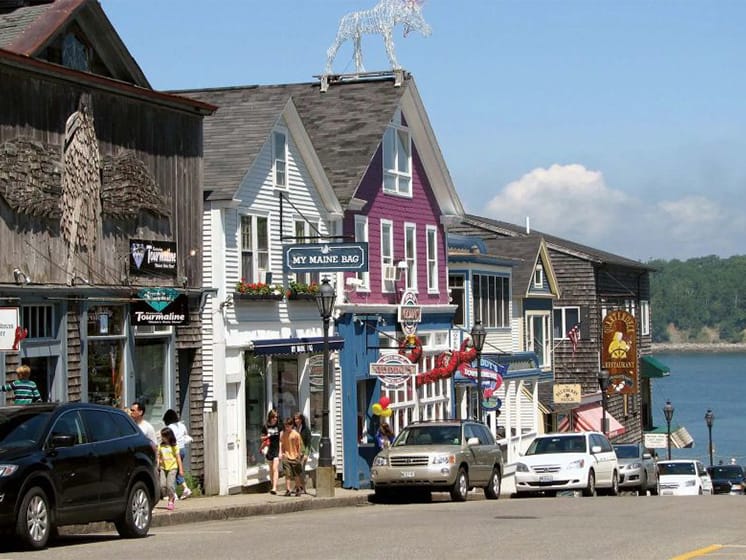
LOON SELFIE
Bar Harbor is a town on Mount Desert Island along Maine’s Frenchman Bay. It serves as a gateway to the mountains and cliffs of neighboring Acadia National Park. Towering over the park, Cadillac Mountain has trails and views of the town, the bay and the Cranberry Islands. Sand Beach is ringed by mountains. From the town pier, the Shore Path winds along the bay overlooking the Atlantic Ocean and the Porcupine Islands.
The town of Bar Harbor was founded on the northeast shore of Mount Desert Island, which the Wabanaki Indians knew as Pemetic, meaning “range of mountains” or “mountains seen at a distance.” The Wabanaki seasonally fish, hunt and gather berries, clams, and other shellfish in the area. They speak of Bar Harbor as Man-es-ayd’ik (“clam-gathering place”) or Ah-bays’auk (“clambake place”), leaving great piles of shells as evidence of this abundance. In early September 1604, French explorer Samuel de Champlain ran aground on a rock ledge believed to be Egg Rock, just off Otter Cliffs, and when he came ashore to repair his boat he met local natives. Champlain named the island Isles des Monts Deserts, meaning “island of barren mountains”—now called Mount Desert Island, the largest island in Maine.
Things to do/see in and around Bar Harbor: Hulls Cove, Acadia, Thunder Hole, Jordan’s Pond House, Gorham & Cadillac Mountains, Boat Tours, Whale Watching, Cuisine Tours, and MUCH more!
bar harbor
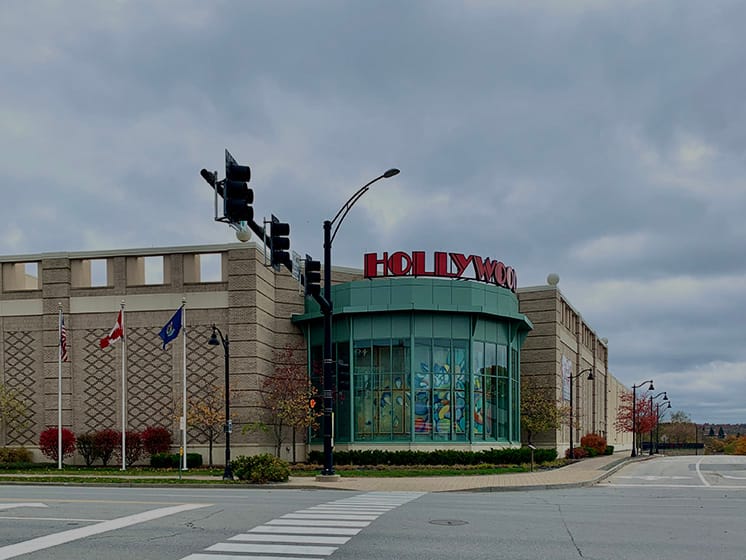
LOON SELFIE
Hollywood Casino Hotel & Raceway Bangor (previously Hollywood Slots and Bangor Raceway) is a casino and harness racing track in Bangor, Maine. It was the first licensed slots facility in the state, and became the first casino to be licensed in the state of Maine when it added table games to its facilities in 2012.
After a full day of non-stop gaming action, you can relax at our luxurious hotel, featuring 148 deluxe rooms and four suites. It’s the perfect escape.
Looking for a Vegas style casino experience thats close to home? Come to Bangor, Maine and enjoy Blackjack and nearly 715 thrilling slots. There are high-stakes thrills and tons of fun at every turn.
Guests new to Hollywood Casino Bangor soon discover that the casino’s appeal goes beyond great gaming. Our restaurants are diverse – their offerings range delicious pub food – complete with 99 different brews – to grab-and-go café with a variety of soups, salads and sandwiches. There’s something for every taste bud, so pull up a seat and order.
bangor hollywood casino

Just a short drive from Cozy Knoll Cabins in Bangor, are two event venues:
- Darling’s Waterfront Pavillion
- Cross Insurance Center
Between the two venues, live events are available for entertainment year round.
For more information, you can use the link below for the events website, as well as links to other venues in Bar Harbor and other Maine Locations.
concerts & more

LOON SELFIE
A stuffed duck recovered from a trash bin has become an international icon….
From US News & World Report:
A detective who created the viral “Duck of Justice” when he rescued a faux waterfowl headed for the trash bin is retiring to write a book.
Lt. Tom Cotton combined his sense of humor with the Bangor Police Department’s social media account to show the human side of police work.
His “Duck of Justice” became a viral sensation as the fowl appeared in various locations before finding a permanent roost in police department, where author Stephen King and others have stopped by for photos.
Along the way, Cotton helped put the city of 30,000 on the social media map with 330,000 Facebook followers — including many outside Maine.
Read the full Duck of Justice article HERE.
see the doj (duck of justice)

LOON SELFIE
Mainers love their beer. And the Bangor area has quite a few local craft breweries; and most of them of full service restaurants in them as well. It’s the best of both worlds – beer and excellent food.
Bangor area breweries include: Sea Dog, Geaghan Borthers, Bangor Beer Co., Black Bear Brewing, Mason’s Brewing Company, Orono Brewing Company, Allagash and MANY more.
If you’re just looking to try the beer and not eat, many of the local breweries have their craft beer available at local grocers as well.
There’s also a yearly festival that many of the brewers attend, called Bangor On Tap. When it comes to craft beer, there’s no place like the Bangor On Tap Craft Beer Festival. We pour our all into finding the best selection of suds from local brewers, as well as craft breweries across the country, for your sampling pleasure. With 100+ hand-selected craft beer styles from 50+ craft breweries featured at each of our craft beer festivals, it’s no easy feat to put on a perfectly crafted experience year after year. But, it’s always worth it, because we like hanging out with you, and we all love an unforgettable party with delicious craft beer.
More info on Bangor On Tap is available in the link.

